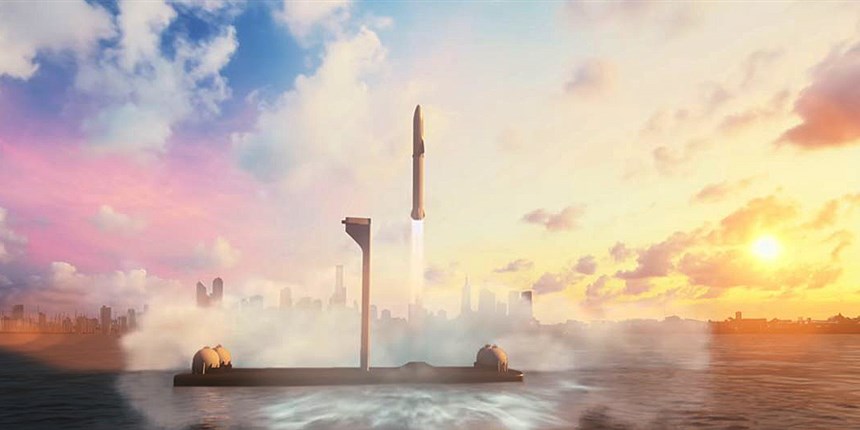
When SpaceX beamed images of a cherry-red Tesla Roadster orbiting Earth, commentators around the world hailed it as a brilliant viral ad for the company’s new Falcon Heavy rocket.
But that hot take missed the much bigger picture.
SpaceX’s successful test launch of the Roadster aboard the Falcon Heavy was less an ad for that rocket than a preview of its planned successor — a booster so stupendous and absurdly powerful that SpaceX CEO Elon Musk calls it “BFR,” for Big F—ing Rocket.
As Musk revealed at a post-launch press conference, the Falcon Heavy will be a cargo-hauling workhorse. To deliver humans into space, he said, “we need to be way bigger than that.” BFR is the rocket Musk is counting on to return astronauts to the moon and to ferry colonists to Mars.

According to SpaceX, the BFR will generate 11.8 million pounds of thrust and be able to carry a 150-ton payload. That far surpasses any rocket now in production, outstripping even the promised capabilities of NASA’s enormous Space Launch System, or SLS. (The names of the two rockets speak volumes about the difference between the cultures of NASA and SpaceX.)
Even more important than BFR’s size will be its cost. SpaceX says the Falcon Heavy will cost about $90 million per launch but aims to make BFR cheaper than that — possibly a lot cheaper — because it will be 100-percent reusable.
In contrast, NASA’s SLS will cost a whopping $1 billion per launch, according to former NASA deputy administrator Lori Garver.
A RACE TO THE BOTTOM ON COST
The staggering expense of the SLS is a key reason why NASA’s long-discussed plans to send astronauts back to the moon and to Mars have remained theoretical exercises. SpaceX’s success with the Falcon Heavy could free NASA from the SLS in favor of vastly more affordable private rockets.
“Government development of SLS was demanded by Congress,” Garver says. “If SpaceX successfully develops BFR, there is no role for SLS. This launch is a game-changer that can save NASA from themselves.”
Dramatic drops in launch cost will have repercussions far beyond NASA, especially if the BFR performs as promised. At the press conference, Musk vowed that “we want a new space race,” a global competition to see who can provide the most capability for the least money.
In reality, that race is well underway.
“Russia and China cannot afford to match Elon on costs,” says Charles Miller, a private-space entrepreneur and advisor to the Trump administration. “Neither can Europe. They all need to go back to the drawing board and reinvent themselves.”
With the Falcon Heavy, SpaceX has already cut the cost of space access by about a factor of 10. If it or one of its competitors can drop the cost by another factor of 10, all kinds of new possibilities emerge.
Countries that currently ride America’s coattails could have human spaceflight programs of their own. Universities, nonprofits, and corporations could claim their own place in space. Space tourism might at long last emerge from the world of science fiction.
ONE SMALL HOP, ONE GIANT LEAP
BFR is still in the planning stages, but it won’t stay there for long. SpaceX has been testing the Raptor engines that will provide thrust for the rocket for nearly two years. Musk predicts short “hopper flights” of BFR hardware in 2019. These will be mini-test launches in which parts of the rocket go up just a few miles to prove their mettle.
First flights of the full BFR hardware could take place around 2022, according to Musk, though he is well known for setting unrealistic timetables. SpaceX announced Falcon Heavy in 2011 with a stated goal that it would need just a couple years for an initial test flight — the one that, in reality, took place this past week.
The shift in strategy from Falcon Heavy to BFR for human spaceflight also means that Musk’s plan to send passengers around the moon sometime this year is definitely not going to happen.

And in many ways, the likeliest reason for engineering delays isn’t the rocket hardware. It’s the crew capsule. The loss of an unmanned rocket would be bad, but a crew death would be catastrophic. As Musk has acknowledged, “The ship part is by far the hardest.”
NASA has sunk nearly $14 billion into the development of its Orion capsule, a successor to the Apollo command module, according to an independent analysis by the Center for a New American Security. In addition, the agency is paying $2.6 billion to SpaceX and $4.2 billion to Boeing to build and fly their own space capsules, the Dragon and CST-1000 Starliner, respectively.
The first crewed flight of the Dragon could take place by year-end, but SpaceX has far greater ambitions here as well. Whereas Dragon will carry seven passengers, BFR’s supersized crew capsule could carry up to 100 — a key element of Musk’s Mars colony dreams.
Size isn’t the only challenge for a space capsule. Interplanetary flights involve very high velocities. No one has yet tested the materials and technologies needed to decelerate from such speeds and land passengers safely on Mars. Nor is it clear whether the cost-cutting techniques that SpaceX has applied to its rockets can similarly drive down the price of a complex crew capsule.
What is clear, though, is that by pressing ahead with the BFR Musk is accelerating the push to make human space exploration more accessible. China has well-known goals to send crews to the moon. More relevant, perhaps, Jeff Bezos has many of the same ambitions for his own low-cost rocket company, Blue Origin.
“I noticed that the one question Elon was unwilling to answer at the press conference was whether he was racing Jeff Bezos,” Miller says. “Why wouldn’t he answer the question? I think Elon is a little scared!”

